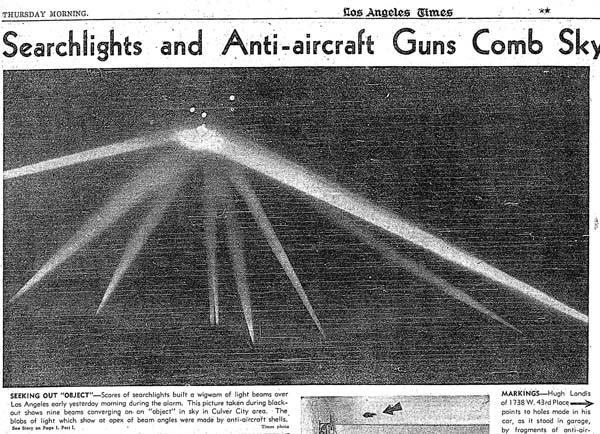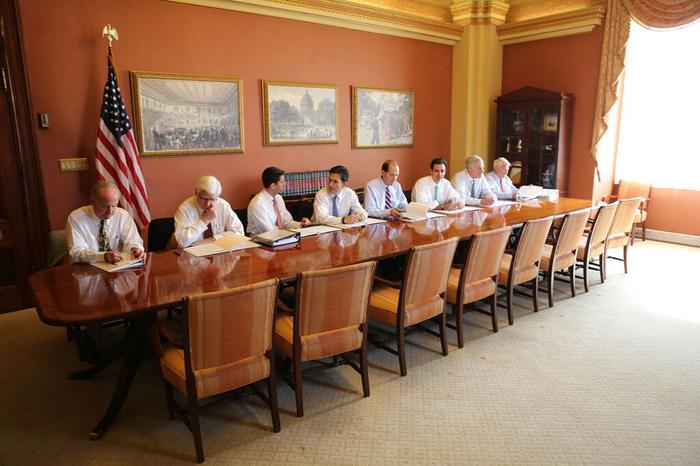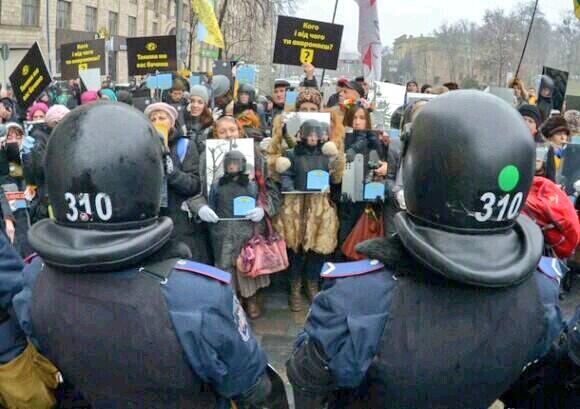
Apparently protestors in Kyiv staged a mirror protest, holding mirrors up to the police. [via @TheBlogPirate]
Category: scott sforza, wh producer
The People’s Guide To Paul Chan’s The People’s Guide To The Republican National Convention
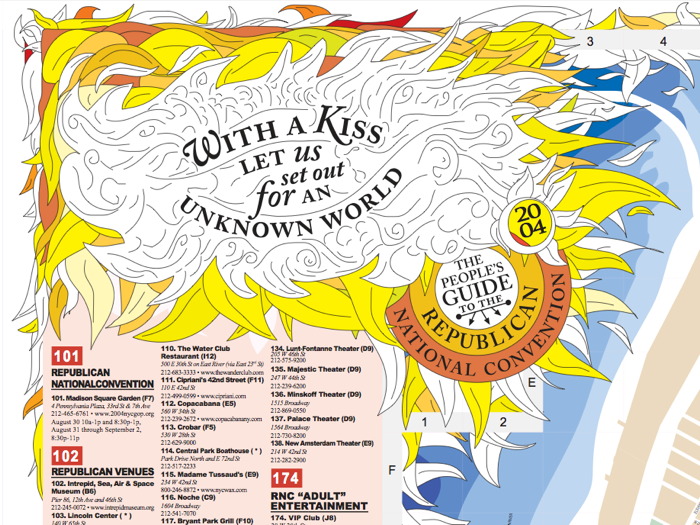
detail of The People’s Guide To The Republican National Convention, by Paul Chan, for Friends of William Blake
Since the NY Times has seen fit to examine the Bloomberg Administration’s rights-defying actions against protestors during the 2004 RNC Convention in New York City, I thought it’d be a good time to look at a remarkable artifact of those protests, Paul Chan & co’s The People’s Guide To The Republican National Convention. Here’s how Paul described it to the CAA Journal last Spring:
The first map I made was in 2004. It was done with a group calling itself Friends of William Blake. I drew Manhattan south of Central Park and we detailed all the events and activities in New York affiliated with the 2004 Republican National Convention. The idea was to make a free map that helped people “get in or out of the way” of the RNC. It worked–to the extent that we showed both protesters and clueless conventioneers the strip-club where the Utah Republican delegation was hosting a fundraiser, and the midtown location of the Dick Cheney gala. The map did not show directions as much as sow havoc.
There are still print copies of The People’s Map to be found, but it looks like Activist Magazine is the only place online that hosts the original PDF [pdf, 1.1mb]. I’m going to host it here in hopes that it’ll get picked up and archived around a bit.
Meanwhile, the rest of Chan’s CAA thing is about the maps in his Waiting For Godot project. Keep reading.
X jxm vlr rpb pelria ilpb vlr Paul Chan [artjournal.collegeart.org]
Mass Arrests During ’04 Convention Leave Big Bill and Lingering Mystery [nyt]
The People’s Guide To The Republican National Convention, original single sheet version, 2004, rncguide_map.pdf [greg.org]
Pete Souza, White House Photographer
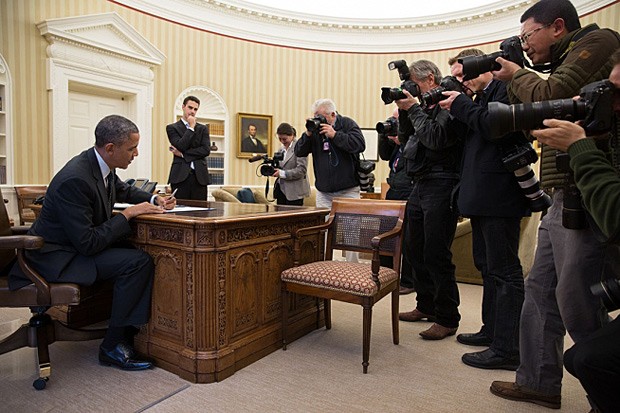
“Oh, just the press getting access to the Oval Office, NBD,” Pete Souza trolled.
It’s almost embarrassing that I did not make the Sforza/Souza connection until this outrage crested. But maybe now is the right moment.
Last month the White House News Photographers Association and 37 other groups and media organizations complained to the White House that they were being frequently blocked or excluded from covering Pres. Obama’s activities. And that the White House was instead releasing its own video and photographs, usually taken by WH official photographer Pete Souza.
Team Obama responded, it seems, by releasing the above Souza picture as the White House Photo of The Day. And as USNews reports [really? They’re even still around?] the “media” were “enraged”:
Julie Mason, SiriusXM POTUS press pool host and former White House Correspondents’ Association board member, saw Friday’s photo and suggested it was an equivalent to a middle finger, a snub and an eye roll. “All of that, plus a drop of anxiety,” Mason wrote in an email. “Behold how sensitive the White House is to claims they shut the press out.”
BagNewsNotes, a website that analyzes images, was the first to notice Friday’s Oval Office picture and called the White House “incredibly petty” for putting it out, arguing that photojournalists should have been offered the opportunity to capture President Obama doing something personal, instead of another staged photo-op.
Personal? Staged photo-op? Are these somehow mutually exclusive? Here’s what BagNews actually wrote:
People in high places should always be mindful how much they are saying, or not saying, with a picture. If the White House intended even a half-respectful gesture, they would have provided access to the president yesterday in a spot that was personal, doing something personal — graciously offering to the visual media (if just to lower the heat and at least suggest you get it) just one of the hundreds, maybe even thousands of scenes only Pete Souza has been privy to for six years now.
Half-respectful gesture? Graciously offering? I guess now I’m at a loss as to what the actual problem is here.
The actual letter sent to press spokesman Jay Carney argues that the WH is wrongly excluding journalists by declaring public, newsworthy White House activities “private,” and then releasing only official photos. But BagNews is complaining about Souza’s insider exclusive on actual “personal” activities. These are completely different types of events.

real or real staged? I can’t tell or remember now.
At first I’d just meant to post a quick plus ça change, because literally the exact same complaint had been lodged by the same photographers against the George W. Bush administration, in 2006. Then the issue came to a head when the White House released a photo of Bush looking out the window of Air Force One on a brief Katrina flyover. Except when I went to look for the image, it turns out that photojournalists had been permitted to take essentially the same shot, including the AP’s Susan Walsh, who filed the 2006 handout complaint.
The issue has not died down, just the opposite. A couple of weeks ago the AP’s Santiago Lyon wrote an op-ed in the NY Times titled, chillingly, “Obama’s Orwellian Image Control.” Lyon cites iconic photos or news-worthy moments that photojournalists captured which “show–surprise–the president is human.” Except all but one of Lyons’ examples were outside the White House [Nixon leaving], straight news [Reagan’s hospital window], or at totally staged press events [GWB’s Sept. 11 bookreading, and his rousing rubble mounting at the WTC.]
The other example, JFK Jr. peeking out from under his father’s Oval Office desk, does not serve Lyon’s argument well. Kennedy had calculated the political value of his children’s images from early in his campaign, and photojournalist Stanley Tretick had become the president’s go-to guy for sympathetic, “human” images. He was the Pete Souza of his day, whose nominal employer happened to be, not the White House, but LOOK Magazine. In October 1963, two months after the death of their third child, and when the overprotective Jackie was vacationing on Aristotle Onassis’ yacht, JFK brought in Tretick for some exclusive hangin-out picture time with the kids. Is this the kind of independent journalistic access the media is clamoring for?
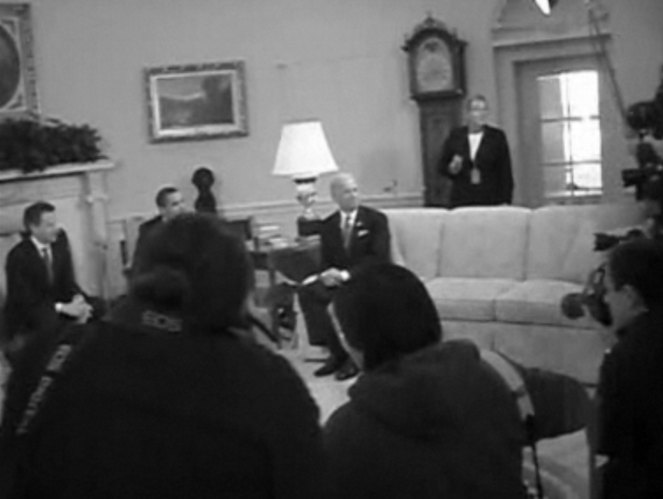
img: still from Stephen Crowley’s epic 32-sec. pool spray video, 2009
I think the journos are totally right to give the administration crap about limits to access; they should push for whatever they can, and raise the political price for the WH’s own communications/image policy. But let’s look at what they’re really arguing over: ‘pool sprays,’ 30-second drive-by photo ops of people doing nothing. Let’s see what we’ve already lost: ‘Sforzian Replays,’ where the president re-performs some act or re-gives a speech for video and still photographers. The White House image machine is weird and complex and conflicted, and everyone wants to control it to their own ends.
If Special Moments or human interest photos are being brought in-White House, then old/corporate/non-government media should come up with a new visual product. And maybe they start by looking around at their own freakshow presence. BagNewsNotes said some photographers read Souza’s image up top as an act of visual aggression, “a subliminal ‘screw you.'” Why don’t they give right back?

img: Jim Watson/AFP
In October, BagNewsNotes posted a notable collection of pictures of House Speaker John Boehner caught in the media scrum during the government shutdown: Shooting Boehner: Shutdown Visuals Meet GOP Aggression:
What’s going on, symbolically of course, are the press members — as the proxies of the people — not just dropping their typical submissiveness but actually challenging Boehner’s destructiveness and irresponsibility.
BNN also calls it “breaking the contract,” [their scare quotes] the contract which apparently precludes media from “panning out,” thereby acknowledging its own circus existence. BNN’s editorial take is that Boehner and the GOP basically brought this chaotic imagery on themselves.
Is there a White House “contract” too, and if so, hasn’t the White House broken it, and mightn’t White House beat photographers protest by taking nothing but complicated and aggressive pictures? If the Obama administration’s only giving them shit images, why don’t they put it in a bag on the White House porch and light it on fire?
White House Pic of the Day of Media Enrages Media [usnews.com]
Shooting Boehner: Shutdown Visuals Meet GOP Aggression [bagnewsnotes]
Limit on Access Stirs Tensions Between White House Photographer and Press Corps [nyt]
Obama’s Orwellian Image Control [nyt]
Previously: It’s all done with mirrors
And previously in the Bush era: WH Beat Photogs Upset At Staged Photographs They Don’t Take
The Confederacy Is Present

Carhartt product placement? image: @catblackfrazier
Talking Points Memo calls it “Rage & Performance Art,” which is complicated only if you let it.
Senators Ted Cruz and Mike Lee and former half-term governor and Fox News personality Sarah Palin headlined a protest at the WWII Memorial today. They were decrying the memorial’s closure as a result of the government shutdown. The shutdown they orchestrated and perpetuate. Personally.
The protestors, Tea Party Republicans and truckers, siezed the barricades and marched them up 17th Street to the White House, where they waved a Confederate flag and demanded President Obama come out with his hands up.

image: @davidfrum
On a process note, it’s interesting that where Sforzian moments were once centrally conceived for and executed by professional photojournalists, nowadays photo-op political stunt events are disseminated through amateur snapshots.

One thing that hasn’t changed, though, is Karl Rove’s Sforzian dictum that you should be able to get the message even if you have the TV sound turned off. And I think that comes across loud and clear.
As in this photo from [decidedly non-amateur, non-bystander] Texas Republican congressman Steve Stockman, which includes a flag behind Palin that cites John Locke’s “appeal to heaven” to call for revolution against the government. [via andrewsullivan.com]
Guantanamo Bay: The Hunger Strikes, by Jonathan Hodgson
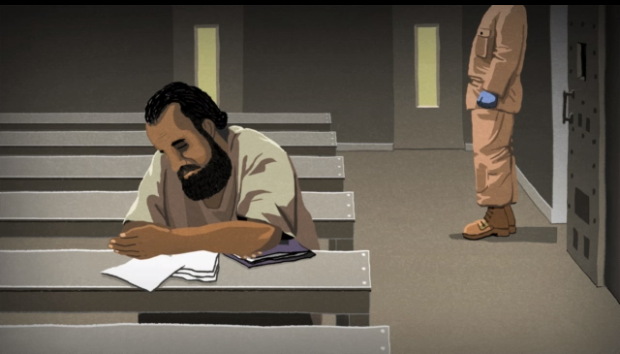
the blue gloves
The Guardian commissioned this animated short by director Jonathan Hodgson about the ongoing hunger strikes by prisoners in Guantanamo. The content and text are all based on testimony of five men who are still imprisoned six years after being cleared for release.
The disturbing treatment depicted in the film is largely dictated by the US military’s standard operating procedure regulation manuals for handling prisoners and administering force feedings.
Guantánamo Bay: The Hunger Strikes – video animation [guardian]
Previously, related: Standard Operating Procedure
American Decay
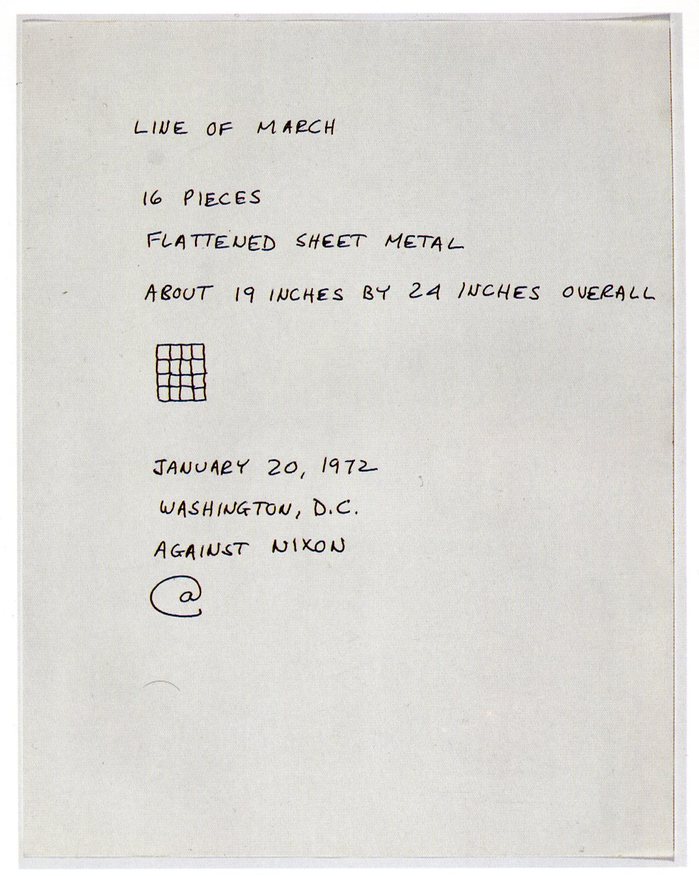
From grupa o.k. comes this 1972 diagram [drawing?] by Carl Andre, Line of March, which describes a smallish floor piece. And it connects to the second inauguration, on January 20, 1972 [sic?], of Richard Nixon.
Courtney Fiske blogged about finding a 1973 ARTNews article about Line of March titled “The politics of cheese.” Andre had found the index card-size sheet metal pieces for the sculpture on his way to Washington, where he’d planned to protest Nixon’s inauguration by installing a work, titled American Decay at Max Protetch’s gallery on M Street:
The piece consisted of 500 pounds of cottage cheese anointed with 10 gallons of ketchup, resting atop tar paper, covering an area about 12 by 18 feet, with the cheese itself about 10 inches deep. Although the piece was not for sale, one collector did take home ten small cans of the Sealtest large-curd cottage cheese.
There were those who felt, on seeing the piece, that Andre had taken an obscurantist stance, but they should remember that during the campaign Nixon’s lunches consisted of cottage cheese coated with ketchup. It has not yet been determined if the cottage cheese Nixon ate was Sealtest large-curd. At any rate, American Decay, which opened at the Protetch Gallery on Jan. 19, closed on Jan. 20 because of the putrid smell which permeated the premises.
I can’t find photos of American Decay, but I will definitely look. It sounds gross, but fantastic.
The student of politics will also note that Nixon’s inauguration actually took place on January 20, 1973, a full year after the date in the drawing above. Gilbert & Lila Sullivan had another Line of March drawing in their collection that does have the “right” date.
So now I really have no idea what this piece of paper is.
To The Sforzian Barricades!
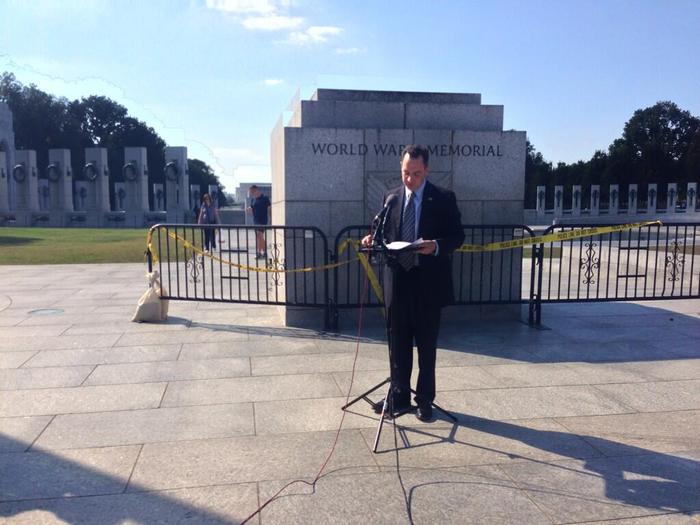
For a brief moment yesterday, the first morning of the GOP-instigated shutdown of the federal government, anxious confusion reigned. And as folks began realizing that in addition to the hundreds of thousands of furloughed and unpaid workers, and the halt to vital government programs across the country, Washington’s museums and memorials were also closed to the public, there was a ray of hope.
A tour group of World War II veterans, The Greatest Generation, were not going to stand for this assault on our great constitutional democratic institutions. So they had someone push them in their wheelchairs into the World War II Memorial as Park Police watched from the sidelines.
Yeah, then it turns out the pushers were some of the same Tea Party extremists in the House who had voted for, nay, clamored for, the government to be shut down in the first place. Last night the likes of Michele Bachmann and Steve King were promising to personally help any veterans group fight their way back into the Memorial any day if they had to. And they just dared Pres. Obama to arrest them all. Ideally, on live cable TV.
Today, with conservative media attention riveted on this Mussolinian plaza which slices the National Mall in two like a hernia operation, Park Police decided to stand aside as congressional tour guides boldly shouted, “Tear down this fence!” and “Stand our ground!” and whatever.
And GOP chairman Reince Priebus himself stood in the glare of cameras and the afternoon sun, brandishing a GOP check and offering to pay to keep the memorial open (for vets) or, in Gawker’s words, “to rent the WWII Memorial for shutdown theater,” and –hey, how’d those people in the background get past Obama’s Black Fence of Tyranny? It’s almost like that little fence was put there, in front of the sign, and strewn with police tape, just so, just to be photographed. Can we get a wide shot on this one?
[image tweeted by HuffPostPol reporter @RyanJReilly: “‘Go do your job, idiot!’ — protestor to @Reince at WWII Memorial”]
Good Government Death Panel
Let’s Crash
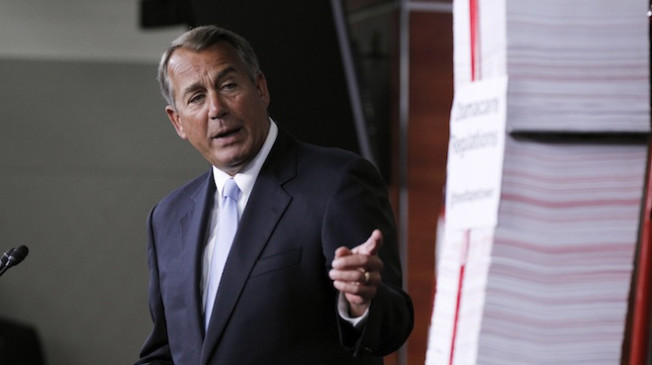
John Boehner pointing to the GOP target on the South Tower of Obamacare printouts, after a strategy meeting of House Republicans, I guess. image: AP/Rilley via TPM
Anxieties were rising on Capitol Hill with deep divisions (both within the GOP and between the two parties) just days before many federal services were set to close their doors. But in their private meeting, House Republicans agreed to unite on the goal that binds them together: wanting to unravel and defeat Obamacare.
“The whole room: ‘Let’s vote!'” Rep. John Culberson (R-TX) told reporters, according to MSNBC. “I said, like 9/11, ‘let’s roll!'” (The congressman was referring to the last words of a passenger aboard a flight that was hijacked on Sept. 11, 2001 and crashed in Pennsylvania.)
House GOPer Compares Delay Obamacare Bill To Fighting 9/11 Hijackers [tpm]
Related: Judging from the Boehner’s flickr stream, the Speaker could use a Souza. [flickr]
I guess this is what the wider shot looked like:

The Enterprise School
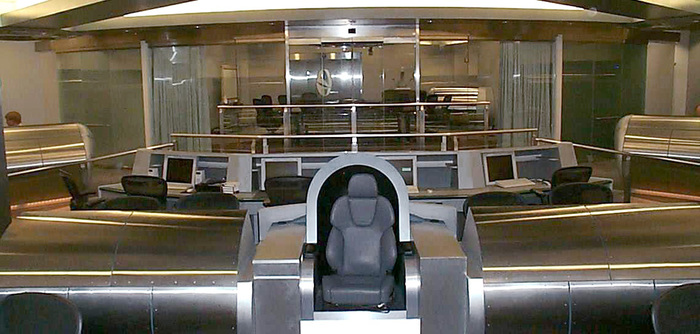
In an extensive profile of the NSA Director, Foreign Policy reports that when Lt. Gen. Keith Alexander was head of Army Intelligence, he built out his “Information Dominance Center” to look like the bridge of the Starship Enterprise:
It had been designed by a Hollywood set designer…complete with chrome panels, computer stations, a huge TV monitor on the forward wall, and doors that made a ‘whoosh’ sound when they slid open and closed. Lawmakers and other important officials took turns sitting in a leather ‘captain’s chair’ in the center of the room and watched as Alexander, a lover of science-fiction movies, showed off his data tools on the big screen.
“Everybody wanted to sit in the chair at least once to pretend he was Jean-Luc Picard,” says a retired officer in charge of VIP visits.
Indeed. And here, I believe, it is.
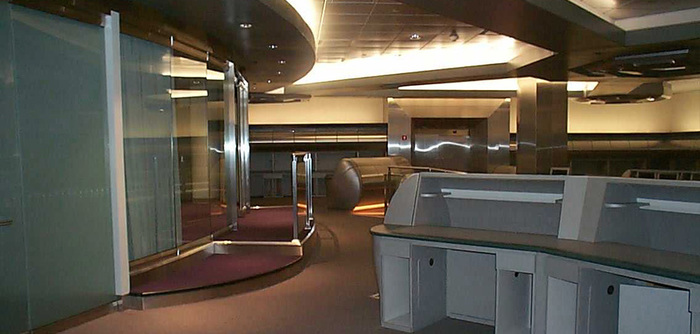
The Information Dominance Center at Fort Belvoir, VA is featured in the portfolio of DBI Architects, a leading DC commercial architecture firm. The firm has done buildouts for absolutely everyone, but in the 1980s, they created a “Stealth Design” practice, focusing on computer rooms and “technology-oriented spaces, including network operation centers, switch sites, data centers, advanced concept laboratories, and video teleconferencing centers.”
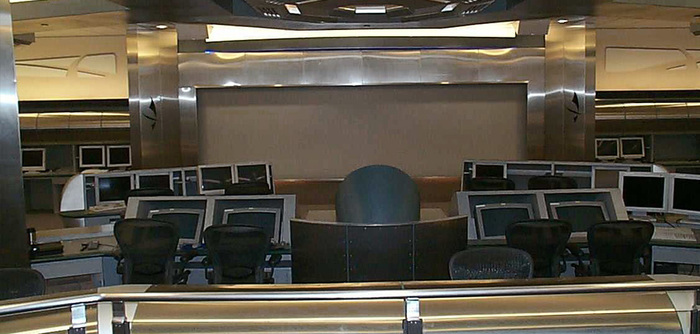
With several top-level command centers under their belt, DBI turns out to be one of the go-to architects for the post-9/11 Intelligence Industrial Complex. Their regional clients include Geo-Eye, the satellite imaging company which powers Google Maps; Lockheed Martin, for whom they build a 50,000-sf control center; various Army intelligence divisions; and even the White House itself. DBI remodeled the WH Situation Room in 2007. They also built the grand, cinematic nerve center of the Department of Homeland Security’s National Counter-Terrorism Center, which was in an undisclosed suburban office park location until George Bush used it as a press corps backdrop in 2006.
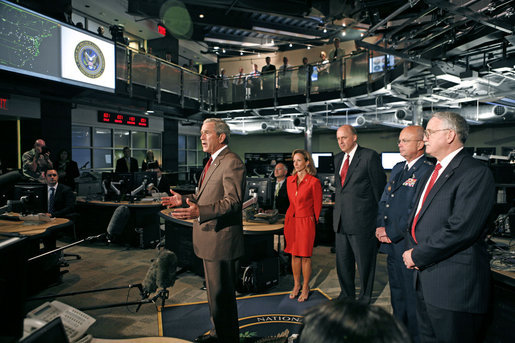
The DBI look is part NASA, part Dr. Strangelove, to NORAD to War Games and on and on, back and forth. The big screened control center is part of the security theatrical tradition now. And in an era of Federation-inspired flip phones and iPads, where the fictional CIA of 24 enabled and rationalized torture at the actual CIA’s hands, we probably shouldn’t be surprised that politicians–of all people–are susceptible to intelligence industry set pieces that look and feel just like a movie.
Previously: But He’ll– He’ll See The Big Board!
Hell Yes, Francois Hollande!

image: reuters via @noonz
My gosh, have I been wrong in trying to ignore French president Francois Hollande all this time?
Watch the video how the robot’s handler, from Aldebaran Robotiques, turns its head toward the cameras. Presumably so it doesn’t look like it’s nursing. [francetvinfo.fr]
The robot told Hollande it’s name was Nao, and that it is seven years old. I would have guessed at least eight:
Algorithm Exercise with QRIO by daisu
Aujourd’hui, c’est la rentrée au 2005

Denis Charlet/AFP
Congratulations, François Hollande, you have made the dumbest on-camera face of any international leader since 2005, when George Bush tried to exit a Beijing press conference through a locked door.

Decision to withdraw unflattering photo of François Hollande is criticised [guardian]
Previously, 2005: Mandate of Heavens to Murgatroid
Dome Half Full
You know what? It’s the little differences.
When Americans think of Buckminster Fuller’s Geodesic dome, they probably remember the eternal, benevolent optimism of the US Pavilion at the 1967 World’s Fair in Montreal. Oh yes, good times.
If only Europe could look back to these days, and past the array of geodesic domes dotting the continent, the ones in which NATO radar dishes and surveillance equipment have been cloaked, then everything would be awesome once again.
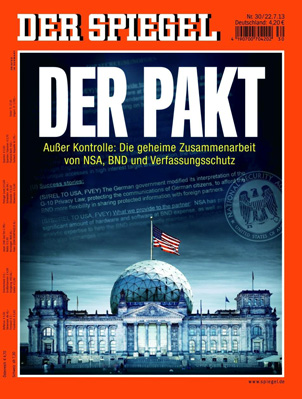
Looks like Der Spiegel didn’t get the memo.
On The Lens of Cultural Histories And The CIA’s Otherwise Concealed Bonds
What spate of unfortunate public disclosures and Oscar losses could ever have precipitated the CIA’s decision to allow coverage of its “museum”? Or maybe what beat needed to be freshly greased by NBC, that it would propose a tour of the awesome, closed-to-the-public historical exhibition spaces at Langley?
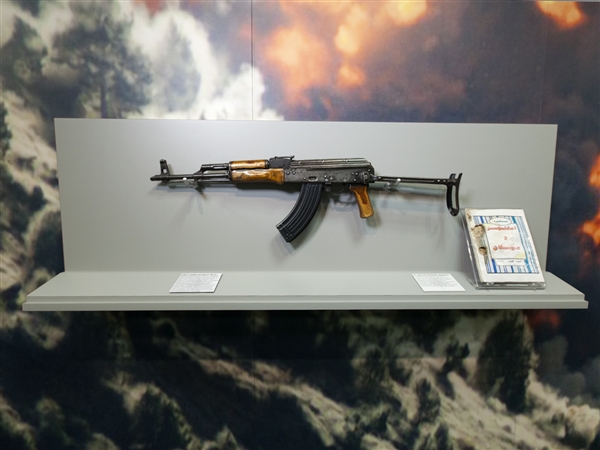
image: John Makely/NBC News
We’ll never really know, but the day before military prosecutors made their closing arguments against Pfc Bradley Manning, we were somehow lucky enough to see the AK-47 that belonged to Osama bin Laden himself, or at least the one that was found, in undiscussed circumstances, near him in the Abottabad room where he was killed.
I am most impressed by its presentation, on a simple painted grey shelf, with a bullet-riddled book of some kind, which is mounted against a tumultuous photomural of, of what, exactly? A massive explosion ripping apart a heavily forested hillside? I’m sure that’s not an image from the botched attack on the caves of Tora Bora, where the US, already chomping at the Iraqi bit, let bin Laden get away in 2002. The CIA would not have such self-criticality [on unclassified display].

Haim Steinbach, installation, 1979, image via bard.edu
But one thing we do know: at least one operative in Langley is a fan of Haim Steinbach.
‘Secret’ CIA museum features Osama bin Laden’s AK-47 [nbcnews]
Haim Steinbach: Once Again The World Is Flat, runs through Dec. 20, 2013 at CCS Bard [bard.edu]
Laserpointer Pyramid
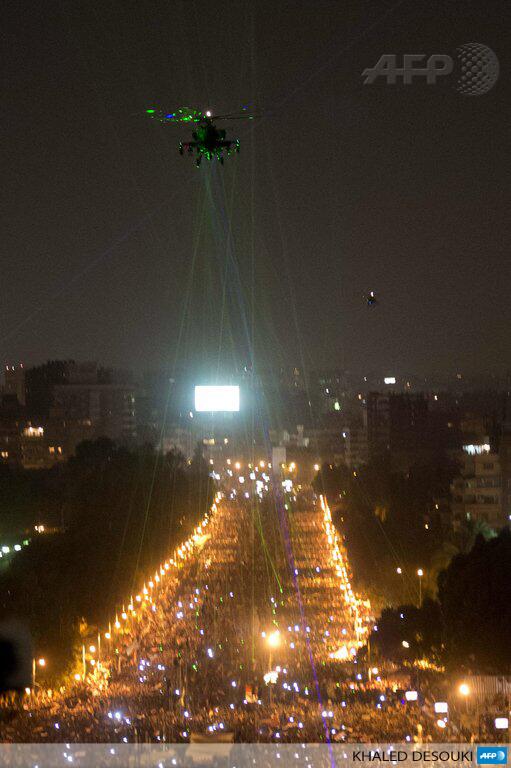
Khaled Desouki’s extraordinary photo of crowds in Cairo tonight forming a pyramid of laserpointers trained on a military helicopter [AFP].
Reminds me of the searchlight wigwam converging on nothing over the skies of a frightened Los Angeles, 1942:
